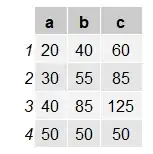It seems typical to include only basic statistics on subject demographics within papers (i.e. mean, max and min). It seems to me that having a knowledge of the actual distribution would be provide more insight, particularly if this could be included in a concise space-efficient manner.
To this end, I have experimented with the inclusion of histograms inline with the text following the sparkline concept. Example below:

Unfortunately, I have received the following comment from a reviewer:
What is that?? This is the first time I see results presented that way!!!
Obviously they have either not understood the data presentation technique or do not like it. It does not seem beneficial to me to expend the space explaining the presentation technique within the paper. So I have the following questions:
- Is this is a useful addition to the paper?
- Is it obvious what these mean?
- What improvements could be made to the way it is presented? (without taking up too much paper space)
- Are there any good alternatives that I'm missing?